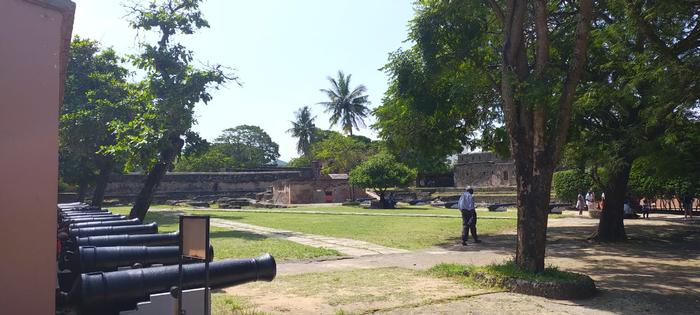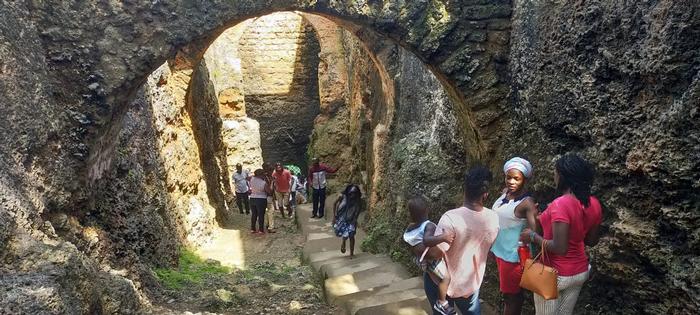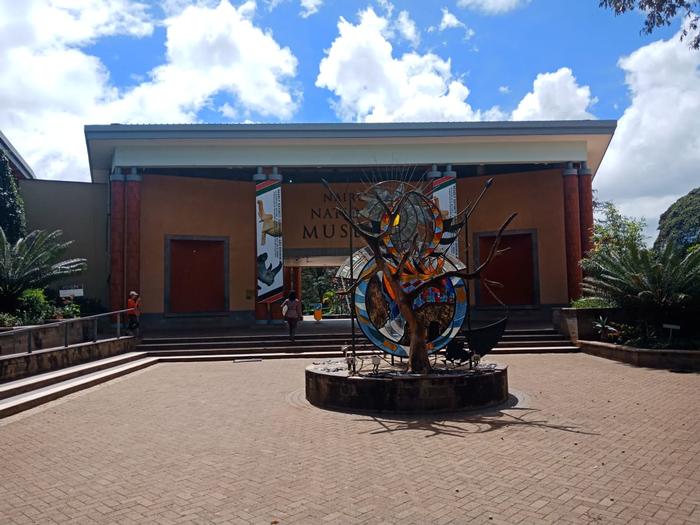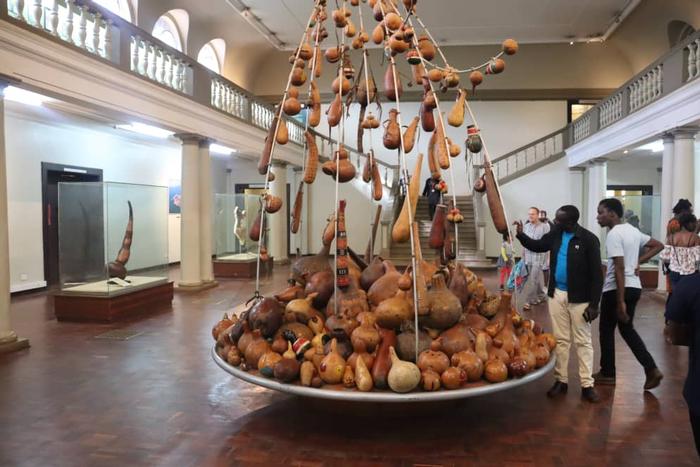[ID:3719] For the love of MuseumsKenya INTRODUCTION
Our partnership is necessitated by the fact that one party is a student architect with a love for historical buildings, while the other is a student of law with admirable experience from working in civic buildings during her internship across the country.
The success of any civic building lies not in the grandeur of the built form but the ability to connect with the humankind. The Louvre in Paris, the Guggenheim in New York and the British museum are some of the world’s most popular museums. These museums boast of some of the most expensive pieces of art ever made like the Mona Lisa, the Rosetta stone and a host of other amazing collections. People not only love these museums because of their expensive pieces but also the history of their very existence. The Louvre for instance was originally built as a fortress in 1190, but was reconstructed in the 16th century to serve as a royal palace. It has since been built and rebuilt over the years to become a bucket list item for many around the world. It is this understanding that informed our selection of Fort Jesus museum in Mombasa and the Nairobi National Museum both in Kenya for an in depth study with regards especially to their genius loci, architecture and other important roles they play in the development of the society.
FORT JESUS MUSEUM
Fort Jesus was built by the Portuguese towards the end of the 16th century. Its designs were strained from the conception of an Italian architect, Pietro Cataneo but drawn by Joao Batista Cairato. With its imposing high walls, five bastions and an aerial view resembling that of a human figure with arms wide open, the fort exhibits military architecture of the Renaissance period. Human labor used during its construction as well as materials: coral rock, masonry stones, burned limestone and soil were all obtained locally with the help of the Swahili people who were the indigenous inhabitants of the region.
The Fort is strategically located on a high ground overlooking Mombasa Old Port, providing a vantage view of the sea. No ship could access the port without its approval and aggressors were easily identified for ambush. Fort Jesus bears testimony to the first successful attempt by the Western civilization to rule the Indian Ocean trade routes.
In spite of its incredible fortification, Fort Jesus’s twisted history of occupation points to an interesting pattern. It was captured and recaptured over the centuries changing hands at least nine times between 1631 and 1895. Sultan Yusuf ibn al-Hasan of Mombasa was the first to seize it from the Portuguese before the Omani Arabs’ extended occupation since 1698. The capture of the fort marked the end of Portuguese presence on the coast, although they briefly captured and re-occupied it between 1728 and 1729 with the help of the Swahili city-states. The fort fell under local rule from 1741 to 1837, when it was again captured by the Omanis and used as a barracks, before its occupation by the British in 1895, after the declaration of the Protectorate of Kenya.
It is believed that slaves were held in the fort’s numerous torture chambers. The high walls of the fort tell stories of how slaves perished from torture, hunger, and diseases as they awaited to be shipped abroad. A local narrative has it that a prisoner once attempted to escape by scaling the wall but fell and broke his legs. It further is alleged that he was re-arrested and hang on a tree to serve as a deterrent to the horrified inmates. Numerous people including renowned Mijikenda woman warrior and leader, Mekatilili wa Menza have fallen victim to the hostile and harsh conditions that were the prison in the fort. Most of them would die and their bodies thrown in the ocean while survivors would eventually be sold as laborers, soldiers or sex slaves.
In 1958, the Fort was declared a national monument with James Kirkman successfully excavating it using external historical documents from 1958 to 1971 and would later open to the public as a museum. Ironically, a section of the local community gave it a wide berth arguing that the fort opened old wounds. They said it was sarcastic to celebrate a prison as a source of pride. Similar sentiments had earlier been voiced by Muyaka bin Haji al-Ghassaniy, an eminent 18th century Swahili poet and author in his famous saying, “Ngome intuumiza naswi tu mumo ngomeni” which means “The fort is hurting us yet we reside inside it”. To this day a good number of these locals view this colossus as a symbol of oppression and would rather have it flattened. Some workers also say that they feel imprisoned by it since the memory of its ancient horrors haunt them. A number of visitors reported that they would never set foot back into the fort since its past experience was one they would rather not re-live.
In a bid to change this, dedicated efforts from successive governments have been put in place to boost conservation and tourist activities. Section 4 of The National Museums and Heritage Act, 2006 of the Laws of Kenya lists the promotion of cultural resources in the social and economic context as one of the functions of National Museums. They also serve as places where research and dissemination of knowledge in all fields of scientific, cultural, technological and human interest may be undertaken. At the heart of these efforts is a robust conservation programme that culminated in the declaration of the fort as a World Heritage Site in 2011 by UNESCO, describing it as one of the most outstanding and well-preserved Portuguese military fortifications of the 16th Century.
The public participation strategy has ensured that the local community understands the role played by the museum not only in generating revenue but also documenting the unfortunate experience visited upon them by hostile regimes as well as teaching young ones about this conservation. Consequently, they have been encouraged to participate through a host of activities. For instance the courtyard found at the periphery of the fort has been opened up for public use and locals now congregate in the evening and use it as a football field. Cultural ceremonies, weddings and musical concerts have become regular occurrences. The restaurant just outside the fort has gained fame as a venue for the culmination of triathlons commonly held in Mombasa as it overlooks the Indian Ocean while the International Museum Day continues to be observed annually in line with Kenya’s obligation to world treaties. Staff at the museum is largely drawn from the local community and the revenue earned from entrance fees is used in more conservation efforts. Fort Jesus is now a popular destination for foreign and local tourism and is important as a host for numerous research programs, a conservation laboratory, an education department, and an Old Town conservation office for Mombasa.
NAIROBI NATIONAL MUSEUM
The amiable Nairobi National Museum buildings straddle the Museum hill that lies west of the central business district of the Kenya’s capital. Its history can traced back to 1929 when the then colonial government, of governor Sir Robert Coryndon, a staunch supporter of the Uganda Natural History Society, set aside land on the hillock for the construction of a small museum. The first gallery would later be officially opened on Monday the 22nd of September 1930 and named Coryndon Museum in his honor. The site was preferred due to its conducive climate besides being adjacent to the Nairobi River whose name comes from the Maasai phrase Enkare Nairobi, which translates to "cool water". On the attainment of independence in 1963, it was re-named Nairobi National Museum. It has since expanded its services and assets to include regional museums, and has acquired under its jurisdiction, sites and monuments which the government has set aside as monuments of national heritage.
The museum boasts of a good range of cultural and natural-history exhibits. A unique welcome of ethnological exhibits can be found on the ground floor of the building with extraordinary artefacts such as the Kalenjin cloak made from the skin of Sykes Monkeys and a mosaic map of Kenya made from a collection of the country’s butterflies. This seems to be a mere prelude as the adjacent room holds “the birds of East Africa exhibition”, dotting a huge gallery of at least nine hundred stuffed specimens. On the upper floors, the Historia ya Kenya (History of Kenya) display, takes you through an engaging journey of Kenyan and by extension the East African region. Well-presented and documented, it offers a refreshingly Kenyan counterpoint to colonial historiographies. Also on this floor, is the Cycles of Life room which is rich in ethnological artefacts from various Kenyan tribes and ethnic groups. This room also houses a permanent exhibition of Joy Adamsons paintings covering Kenya’s tribes. There is also a hall of exhibits adjoining this one that brings you one foot away from a lion staring straight into your eyeballs. The popular John Michuki Snake Park to the north of the grounds provides the witty with exhibits of live snakes kept for research. The museum is also home to a host of rescued reptiles and amphibians. In addition to the exhibits, there is a life-size fiberglass model of a celebrity elephant named Ahmed of Marsabit. The elephant became the symbol of anti-poaching efforts in Kenya at the height of the 1980’s poaching crisis. With all these preserved artefacts from almost all the forty seven ethnic groupings in Kenya, one cannot help but give in to the euphoric sense of patriotism and pride in being Kenyan.
Art, food and cultural festivals are held at the museum and many schools organize trips to the museum. Continued local attraction and tourism can be greatly attributed to the relaxing ambience at the botanical gardens, the spacious outdoor amphitheater and the Louis Leakey auditorium that are available to the public. The main entry gallery is also synonymous with public speeches delivered to the citizens of Kenya thus further affiliating the Museum as a symbol of National Heritage. From time to time, the museum’s facilities have been used as a venue for national dialogue, promoting national cohesion. Student competitions are organized by the museum in a bid to continue promoting awareness about the diverse cultures in Kenya.
Most of the museum’s international acclaim can be attributed to the archeological discoveries of Louis Leakey. The Olduvai Gorge discoveries by Leakey and his wife Mary, led to Kenya being referred to as the ‘cradle of humanity’ or as the ‘birthplace of humankind’. These fossils are currently domiciled in the Nairobi National Museum. The fossils of Paranthropus bosei, a hominid dating back between one and two million years have been kept at the museum. The museum is also home to the only known specimen of Homo rudolfensis, thought to have lived over one and a half million years ago. The Turkana boy is another popular fossil. This near-complete human skeleton of a young boy thought to have been around eight years old, at the time of his death and lived close to two million years ago was discovered near Lake Turkana in 1984.
The museum is also used as a research center for selected tropical and contemporary diseases including HIV/AIDS. It also maintains a large but close-knit supportive regional and international community. The museum has established collaborations, research and development programmes like the Institute of Primate Research and RISSEA (Research Institute of Swahili Studies of Eastern Africa) to name but a few. It is through this international community that the museum got facilitation of an upgrade as it was funded by the European Union. Kenyan architects working as staff and Triad Architects together with visiting architects from the European Union worked hand in hand with local communities through stakeholder meetings to come up with a suitable design that integrated views from the locals while maintaining an international appeal.
In a bid to keep abreast with changes in the environment in which it operates, the museum had to redefine its operations to become more responsive to the changing circumstances. This meant moving towards developing the museum as a place where people from all walks of life can meet and have a dialogue on various socio-economic issues. A digitization project has enabled significant automation of operations at the museum although there is still plenty of room for improvement. That notwithstanding, the museum can now be regarded as a magnificent piece of architecture ready to compete with other world-famous museums in drawing visitors from all over the world.
Section 17 of The National Museums and Heritage Act, 2006 confers powers to conduct research to the Nairobi National Museum. The Act stipulates that the National Museums may, so far as its financial and other resources permit, undertake research and conduct other activities of scientific, cultural, technological or human interest by means of lectures, exhibits, tours or publications. Furthermore, the administration of Kenya’s cultural heritage is informed by the Kenya National Policy on Culture and Heritage (NPCH) and by the provisions of articles 11, 40, and 69 of the Kenya Constitution, 2010. According to the NPCH , the onset of colonialism imposed foreign languages, values, beliefs, lifestyles and traditions, thereby suppressing indigenous elements of culture and heritage and alienating Kenyans from many of their cultural practices. The colonizers imposed various legislations and institutions with the objective of protecting their own cultural, political and economic interests. Such punitive legislations and institutions can only be changed through the activities of legal practitioners, historians and other activists. Legal framework for the repatriation of ‘stolen’ artefacts must also be established to recover Kenyan artefacts that were lost during the colonial rule. Adequate judicial processes must complement research and activism in order to recover and repatriate these lost artefacts.
A civic building that puts its community at the center of its management and development is bound to be timeless. A building for the people by the people is never rejected but always emulated and protected by the people. Civic buildings and museums in this case must accept that they have a duty to serve the whole community within which they operate especially in developing countries with plurality of cultures which are sometimes antagonistic to each other. A step further into serving the regional and even the international community immortalizes the structure and what it encloses.
REFERENCES:
The constitution of Kenya, 2010 Duxburry N, Hosagrahar J, and Pascual J (2016) “Why must culture be at the heart of sustainable urban development?” Barcelona: United Cities and Local Governments. Fort Jesus, Mombasa. Retrieved from https://whc.unesco.org/en/list/1295/
If you would like to contact this author, please send a request to info@berkeleyprize.org. |




